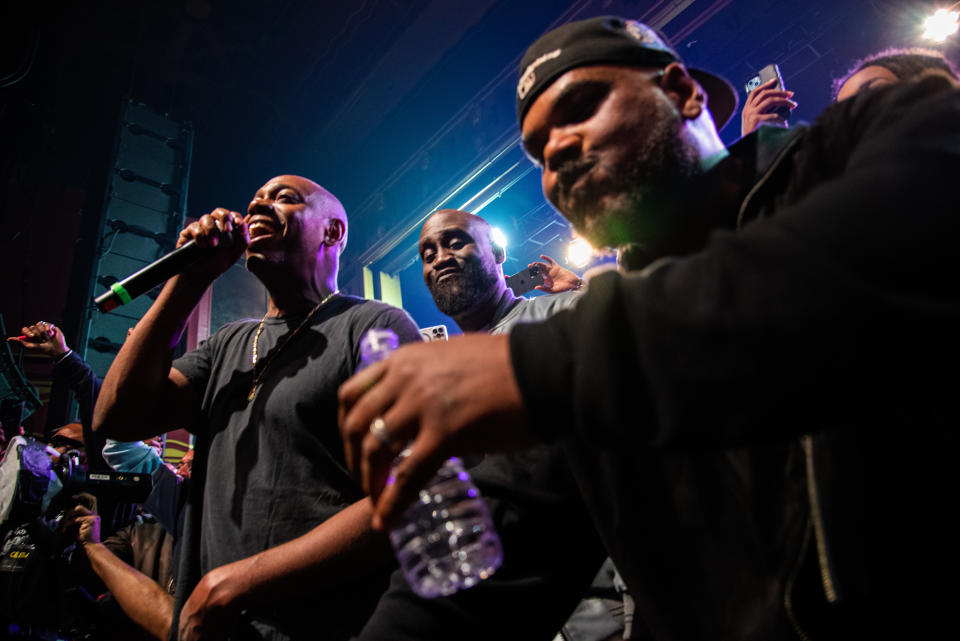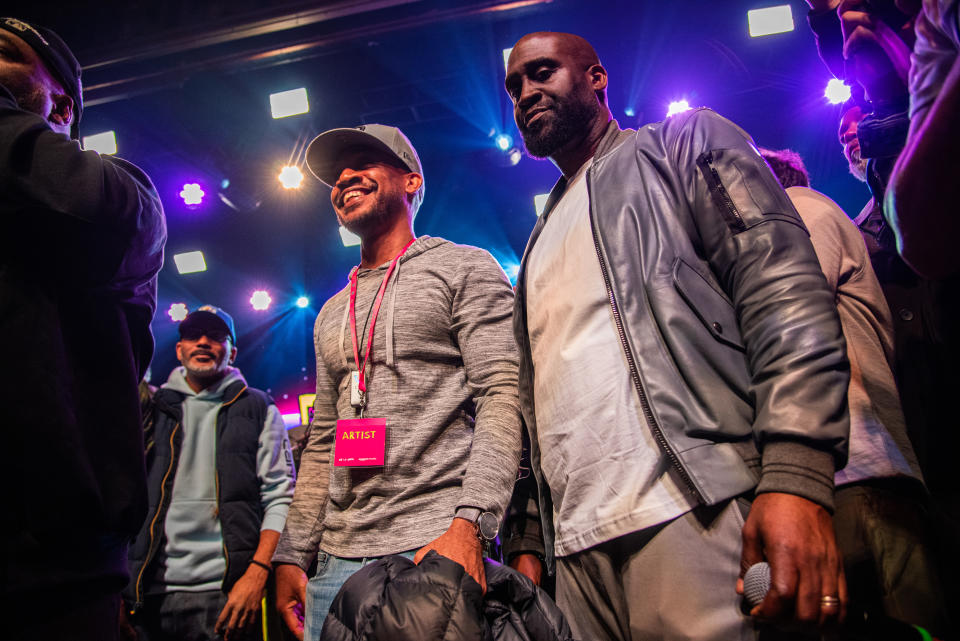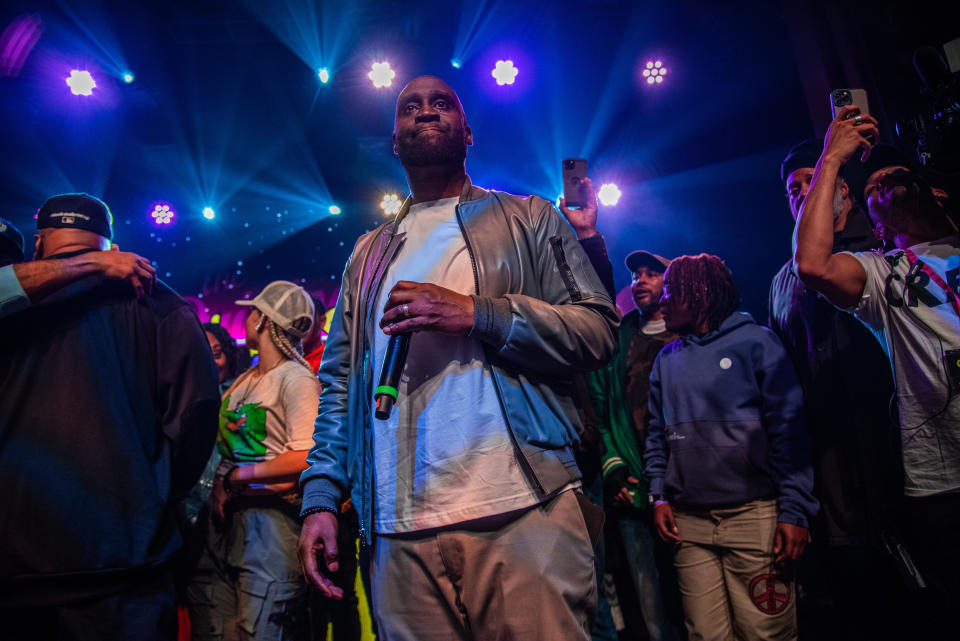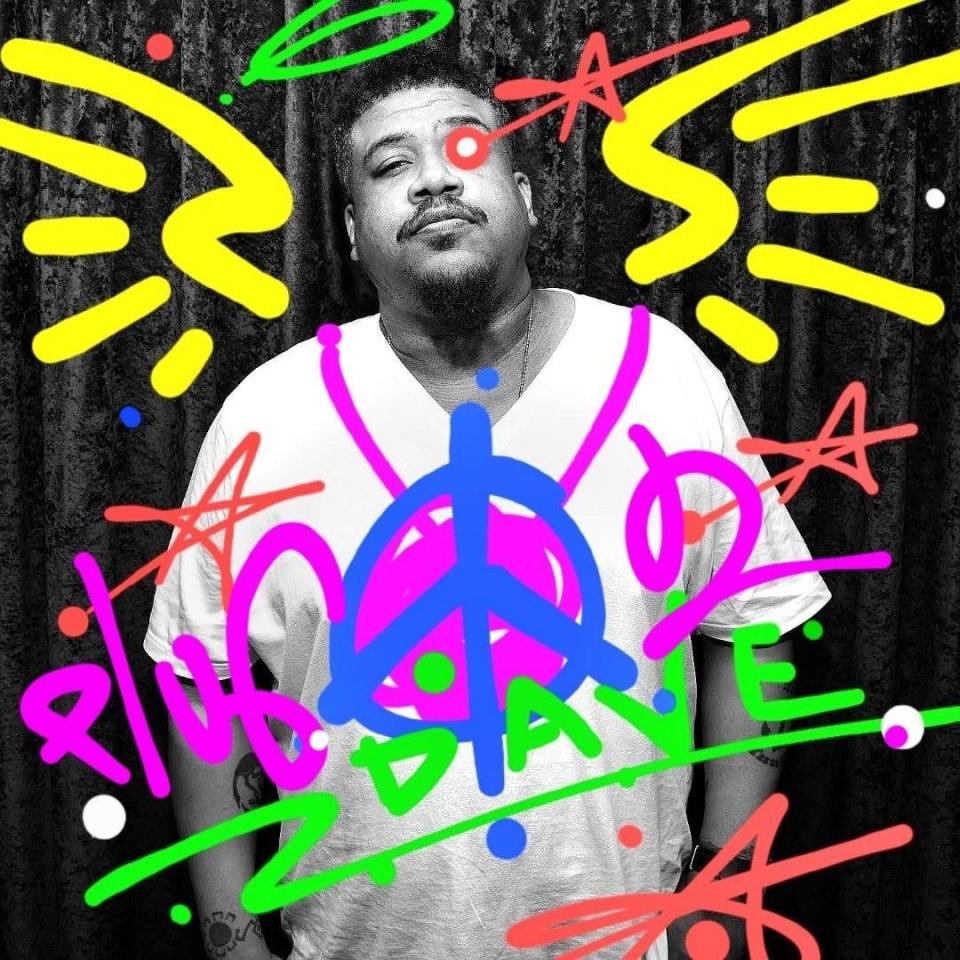When A Daisy Grows In Your Mind
- Oops!Something went wrong.Please try again later.
- Oops!Something went wrong.Please try again later.
- Oops!Something went wrong.Please try again later.

Thirty-four years ago, De La Soul released their groundbreaking debut album, 3 Feet High and Rising—which has only now appeared for the first time on digital streaming platforms. Over a third of a century later, the sonic masterpiece these three high school friends from New York’s Long Island created still sounds ahead of its time.
“On a serious tip, we don’t think that we so different,” says Posdnuous aka Plug One in the group’s first promo video from Tommy Boy Records. “It’s just that everybody tryin’ to be the same.”
More from VIBE.com
Chris Rock Says He Lives His "Mothaf**kin' Life" By De La Soul's "In The Woods"
Posdnuos Of De La Soul Talks The Creation Of "Me, Myself And I"
De La Soul Discusses Seeing Themselves In Odd Future In Unearthed Interview
On March 2nd, at the storied NYC venue Webster Hall, a capacity crowd of De La fans and Hip-Hop royalty—from Queen Latifah and Monie Love to Busta Rhymes, Q-Tip, Common, and DJ Red Alert to name a few—counted down the seconds until 3 Feet High and five other culture-shifting De La albums were finally unchained from decades-long digital purgatory. What should have been an utterly joyous occasion was also tinged with melancholy because Trugoy the Dove aka Plug Two had passed away less than three weeks before the date the group had fought and prayed for. The celebration of De La’s music had also become a celebration of David Jolicoeur’s life.
“It’s a great time for us,” said Posdnuous from the Webster Hall stage. “And like I said, man, I’m really grateful for my brother Dave. When [his death] happened, I was like ‘Damn, Dave! We was almost here. You coulda saw it!’” But at that very moment his emotions had shifted from grief to gratitude. “Thank you for being our mentor,” he said. “Yo dog, we are here.” And then he checked the time. “Oh sh*t! It’s 11:59.”
With that Pos passed the mic to “another Dave,” Chappelle to be specific. “Count down the last 10 seconds cause this is history,” said the comedian and staunch Hip-Hop advocate. “We’ve waited a long time for this music to be available and right now, in just a few seconds, you have every opportunity to support these brothers and let ’em know what they mean to you… As Dave said, “Let my headstone read that I did it for us.”

And then, just before the final countdown commenced and the colorful daisy shaped balloons came raining down from the ceiling, Chappelle added an insightful observation: “These guys were the Big Bang for some of the most beautiful things that happened in our culture.”
____________
De La Soul’s first album title was inspired by a Johnny Cash song released in 1959—30 years before De La’s debut and long before Posdnous, Trugoy the Dove, Pasemaster Mase, and the album’s producer Prince Paul were even born. At a time when many Hip-Hop beatmakers were sampling James Brown breaks, these eccentric Black teenagers from Amityville, New York were digging in the country and western crates—and lots of other eclectic sounds, too.
“In 1937, the Mississippi River went over the bank and broke the levees,” Johnny Cash once explained. “Flooded the cotton land along northeast Arkansas where me and my parents lived… and we were warned we had to head for the hills.” Cash’s father stayed with the house as long as he could, inspiring a song called “Five Feet High and Rising,” which unfolds as a kind of dialog with his Dad sitting on the front porch of the family house as the floodwaters rise.
“How high’s the water Mama?”
“Three feet high and rising.”
“How high’s the water Papa?”
“She said ‘it’s three feet high and rising.’ Well, the hives are gone, I lost my bees, chickens are sleeping in the willow trees, cows in water up past their knees. Three feet high and rising.”
The Johnny Cash song is sampled near the end of “The Magic Number,” a track from the album that’s literally a collage of samples, but primarily built around the hook to a song from the educational cartoon series Schoolhouse Rock. If you’re starting to get the idea that De La was on some other sh*t, you are correct.
On January 27th of this year, I had the privilege of speaking with Kelvin “Posdnous” Mercer, David “Trugoy the Dove” Jolicoeur, and Vincent “PA Mase” Mason for a wide-ranging interview whose purpose was to introduce young listeners to the remarkable body of work they were about to encounter via their DSP devices. 3 Feet High and Rising and five other massively influential De La projects—De La Soul Is Dead (1991), Buhloone Mindstate (1994) Stakes Is High (1996), Art Official Intelligence: Mosaic Thump (2000) and AOI: Bonix (2001)—have been largely unknown to the current generation due to ongoing sample clearance issues and label disputes.
Mase reminisced about “Buddy,” the first Native Tongues collab, contrasting the album version from the remix. Pos chose “Tread Water,” an inspirational cut on which Dave asks animals—Mr. Crocodile, Mr. Squirrel, et al.—about the best ways of keeping one’s head above the rising tide. After some deliberation, Dave went with “This Is A Recording 4 Living in a Fulltime Era (L.I.F.E.),” praising Posdnous’s production without bragging about his own brilliant bars. “Pause for the poets of a new style of speak,” Dave says on that record—not the first time he’d referred to De La’s densely coded raps as poetry, revealing the artistic ambitions behind their class clown facade. We had so much fun chopping it up that we only made it through the first three albums, parting with plans for a follow up call after the big Hip-Hop 50 tribute at the 2023 Grammy Awards. At no time did I suspect that I would be the last U.S. journalist blessed with the opportunity to speak with Plugs One, Two, and Three all at once.
I didn’t blink when De La’s longtime publicist Tony Ferguson mentioned in passing that one of the members of the group was dealing with a health issue—or when Pos popped up during the Grammys tribute rapping “Me Myself and I” solo. For me, the trio from Amityville, Long Island would always be the unflappably cool teenage nerds, masters of “the subtle art of not giving a fu** what ‘people’ thought,” as Black Thought put it. Listening to their ill beats and bugged-out skits always took me back to the late ’80s, when every block in New York was plastered with posters of DayGlo daisies.
Having battled record labels for so long to win their fair share of streaming profits, and after sorting through the hundreds of complex sample clearances that bedeviled their catalog for decades, what could possibly get in the way of De La’s well-deserved victory lap? Three of the culture’s most important and overlooked geniuses were finally getting their flowers—a big bouquet of daisies, of course—while they were alive to smell them. Then, on Feb. 12, came the unbearable news. Dave was dead at the age of 54 from congestive heart failure.
Like Dark Matter in deep space, we can prove the existence of De La Soul simply by measuring the group’s impact on literally everything else—not just on members of the Native Tongues collective, or direct collaborators like Mos Def, Common, MF Doom, but also on The Roots, Souls of Mischief, The Pharcyde, Little Brother, Outkast, Pharrell, Kanye, Drake, and the list goes on. Dante Ross, their former A&R at Tommy Boy Records, calls them “probably the greatest rap group of all time.”
“If there was no De La Soul there would be no Kendrick,” said Renee Neufville of the R&B duo Zhane, who sang on De La’s 1996 album, Stakes Is High. Six years after she made this bold assertion, Kendrick paid homage to De La Soul’s 1989 album cut “Take It Off” on “N95,” the lead single from Mr. Morale & The Big Steppers.
“Wow, cool,” said Dave, who hadn’t heard the song when I mentioned it. I encouraged him to check it out so we could revisit that discussion the next time we spoke. “Can we pick this up again one day soon?” I asked.
“Yes, sure,” said Dave.
The last time we all connected was when I interviewed the group for my 2016 documentary De La Soul Is Not Dead. They had just crowdsourced over $600,000 to fund And The Anonymous Nobody…, their first album in 12 years, also (incredibly) their first to be nominated for a Best Rap Album Grammy. The album title—much like the group’s name—had come from Dave, who used the handle “Anonymous Nobody” on checks when making charitable donations.
“We needed freedom to release a record that was just totally the way we wanted it to be,” Dave told me at the time, saying it was “overwhelming” how much fans were willing to contribute for the project via Kickstarter—six times more than De La’s stated goal. “Those 11,000 people saved our lives,” he said. “They kinda gave us this boost of confidence to say, ‘Yeah, you know, you guys are still wanted out there. You can still do this.’”
Hard as it was to imagine that the man who rapped the chorus on Tribe’s “Award Tour,” and De La’s entire guest verse on Gorillaz’ Grammy-winning smash hit “Feel Good Inc,” needed any sort of boost, we can all use a soul vitamin from time to time. This was the same bold truth-teller whose brutal honesty propelled the title track of Stakes Is High. “I’m sick of bi**es shakin’ a**es,” Dave snarled in that legendary verse, disregarding whoever might catch feelings. “I’m sick of talkin’ about blunts. Sick of Versace glasses. Sick of slang. Sick of half-ass awards shows. Sick of name brand clothes…”
“Dave had a very palpable way of expressing his contempt,” said the legendary Media Assassin Harry Allen after the artist’s passing. “The ‘9 Sicknesses’ with which he begins his entry on ‘Stakes is High,’ accompanied by the images of his washing and drying clothes in a laundromat is one of the most powerful synergisms I‘ve ever witnessed in Hip-Hop.”
The trappings of rap stardom never held much appeal for David Jude Jolicouer. Born in Brooklyn to Haitian-American parents before moving to Long Island, he considered himself a writer, a poet—an artist first and foremost. When De La’s debut blew up off the success of the hit single “Me Myself and I,” Plug Two refused to get gassed.
“It was like an act of God almost,” Prince Paul told me in De La Soul Is Not Dead, remembering the moment he found out three of his classmates at Amity Memorial High School had formed a rap group. “I was in 12th,” recalled the respected DJ who’d recently begun working with Stetsasonic. “Dave was 11th, Pos was in 10th, and Mase was in 9th.”
Decades after De La’s landmark debut, Paul still marvels at the odds: “With my weird personality and their quirkiness, how did we come together? Like, it’s just indescribable to me. It freaks me out sometimes if I really put some thought into it.”

It was Mase who slipped Paul the demo for “Plug Tunin’,” a song that started as a live routine. Pos had found an old doo-wop record with a sick break—“Written on the Wall” by The Invitations—and looped it up as a pause tape to make the early recording in Mase’s bedroom. One side of the 45 said “Plug Side”—industry code instructing DJs to play that song. Of course, De La sampled the other side, but soon began calling each other “Plug One,” Plug Two,” and “Plug Three.”


“It seems like yesterday when ‘Plug Tunin’ dropped,” recalls Bill Stephney legendary music executive and Public Enemy producer, another force within the burgeoning Strong Island Hip-Hop scene along with the likes of rap group EPMD. “We couldn’t believe that there were brehs even more far out than we were from Long Island.”
Monica Lynch, the former president of Tommy Boy, told me about her first meeting with the group: “They came in, they said, ‘Well my name’s Posdnuos, which is ‘sop sound’ backwards. And my name is Trugoy, which is ‘yogurt’ spelled backwards.” Weird as they seemed, she thought they were pretty fantastic. “They had these unusual haircuts,” she recalled, “and their style was completely antithetical to the prevailing aesthetic of Hip-Hop at the time.”
“Tommy Boy used to have offices on the upper east side,” recalls veteran rap scribe Michael A. Gonzales. “They were not glamorous at all.” One afternoon he stopped by to find Daddy O from Stetsasonic hyping this new group called De La Soul. Monica Lynch gave him their first cassette single. “I felt like I was those guys,” Gonzales says. “I wasn’t Big Daddy Kane. I wasn’t KRS ONE. I loved all their shit, but the first ones who channeled that nerdboy aesthetic was De La Soul. They were the guys you could imagine going to a comic book convention with or going home watching Star Trek.”
It was clear from the outset that De La was on some other sh*t. Common, who spit a hot verse on the Stakes Is High album, recalled hearing “Plug Tunin’” for the first time when a friend played him a Red Alert tape from NYC. “It was one of the most innovative, fresh, unique songs & sounds I had ever heard,” he posted on IG shortly after Dave’s death.
When Tommy Boy released the 12” single of “Plug Tunin’” in 1988, the song was subtitled (Are You Ready For This?) “Yo Pos and Dove,” Mase said at the top of the record. “Stand clear to be plugged up into line one and two so y’all can flaunt that new style of speak.” The album version that appeared on March 3 of the following year was subtitled “Last Chance to Comprehend.”
Even those who did not fully comprehend were feeling the vibe. “Because of the new way they had of rhyming, their approach to language, I think a lot of people may have thought that the album was just silly,” said Harry Allen, who would be one of the first journalists to meet and interview De La Soul. “A lot of it went over people’s heads.”
“3 Feet High and Rising kinda set the stage for us being kids, having a good time outta high school,” Dave told me. “Being jerks, being silly.”
But when the album blew up and the music industry machinery kicked into high gear, Dave came up with the title of their sophomore album De La Soul Is Dead—much to the record label’s horror. “We was having a good time joking around and sticking to our stupidity,” Dave explained. During a meeting at Rush Managment Dave erased all of De La’s tour dates from the official scheduling board and wrote “De La Soul is dead” as a joke. “We all started dying laughing,” Pos recalled. “You know, like, he was just tired of, it, ‘Yo I wanna stay home. I don’t want to go out on the road.”
Along with the usual stresses of tour life, De La Soul were feeling the pressure of Tommy Boy’s marketing strategy. Their concept of the “D.A.I.S.Y. Age,” an acronym for “Da Inner Sound Y’all” was coopted from a mantra of individuality to literal daisies. “Every damn photo shoot you could bet there was a florist hangin’ around with flowers,” said Dave. “It was just like, come on man, flowers? That’s not really what it’s about. That’s what got horrible, seeing them damn daisies everywhere we went.”
The floral arrangements were part of a dumbed-down caricature of De La Soul as the “hippies of Hip-Hop.” This “non-threatening” peace and love image proved commercially appealing, especially to suburban white listeners—spawning follow-up duos like UMCs and P.M. Dawn. But for young Black men on late ’80s Hip-Hop tours, sh*t could get real.
“I think people expected De La Soul to be these loving flower-power soul children,” Dave told me. “And there was a lot of testing happening on the road. People think that, you know, we could step on these little guys, these kids. They want to test them Long Island kids who had flowers in their pictures.” The group had to knuckle up more than once to defend their respect. Prince Paul remembered random people coming up to him, like, “Yo, you know your boys out on the road? I heard they beat up such and such!”

Through the years the daily grind went on and ups and downs with their Native Tongues brethren, and a simmering beef with Tupac, who felt slighted by some of De La’s critiques of rap game cliches. Weary of being tested, Plug Two dropped the semordnilap Trugoy the Dove and started going by Dave. But his biggest battles went on—more spiritual than physical, questions of integrity and artistic vision.
During our last conference call, the final song he wanted to talk about was “Breakadawn,” a smoothed-out single from Buhloone Mindstate built around a lovely Michael Jackson sample. “Breakadawn is a song that I will never gravitate to,” Dave said. “I just don’t feel it. I just get nothing from it. I think my sentiment somewhere in the back of my mind is, ‘I am tired of these popcorn radio records that the label is looking for us to do.’ It almost felt like a slave record.”
“Damn,” I gasped. Up until this point the call had been mostly fond reminiscing over favorite tracks. Whether he and his brothers ever dreamed of rap stardom or not, Dave had reached a point of disillusionment with Hip-Hop as a career.
____________
With their music finally on streaming platforms, De La Soul has some cool gigs in the works. There will be shows at the Royal Albert Hall in London and the O2 Academy in Glasgow. Pos and Mase will keep the torch burning for the De La faithful and represent for their brother as they have been doing for some time now.
Those paying close attention may have noticed that it was Pos who joined Billie Eilish and Damon Albarn at Coachella 2022 to rap Dave’s verse for “Feel Good Inc.” Way back in 2017, Dave shared his health issues with fans in the video for “Royalty Capes,” a single from And The Anonymous Nobody… the final music video released during his lifetime. In true De La Soul fashion, his candor is casually merciless.
Relating the story of how he fell asleep one morning while leaning against his refrigerator, Dave speaks of his brush with mortality almost casually: “The diagnosis that I received as soon as I got to the hospital was that congestive heart failure was working itself on me again,” he says. In the video, he can be seen with a bulky medical device slung over his shoulder. “Right now,” he said, “I’m wearing this, which is called a Life Vest.” Looking straight into the camera he adds, “It’ll shock me and hopefully bring me back from the matrix.” The final words in the video intro reveal how much his health had impacted his work with De La. “I’m ready just to get back to the stage,” he says. “I miss it. I love traveling. I love being around my guys. And I want that back.”
Plug Two takes the first verse on “Royalty Capes.” Following that intro segment, lines like “salute life when dawn breaks” carried an added resonance. And they sure hit different today.
The morning after the Dove ascended, I pulled out my iPhone to soothe my soul. Only two tracks from 3 Feet High and Rising were available so I played “The Magic Number” and “Eye Know” on repeat all day. The drums on “Magic Number” were crazy, driving home Dave’s vivid description of the act of creation—“Mmm when a D.A.I.S.Y. grows in your mind.” And punctuating Pos’s affirmation of how blessed these school chums had been to start this incredible journey 34 years ago. “Without my one and two, where would there be? My three, Mase Pos and Me, and that’s the magic number.”
Even after all their albums, the outro to “Royalty Capes” will serve a fitting coda to Dave and De La’s singular trajectory—still rising after all these years.
We are an army of stars unleashed
The sky takes notes when we speak
Our capes move with the wind
Because of the wings beneath
This is royalty

Best of VIBE.com

